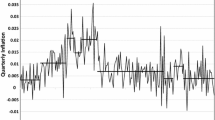Abstract
In this article we show via simulations how the stochastic permanent break (STOPBREAK) model proposed by Engle and Smith (1999) is related with the fractionally integrated hypotheses. This connection was established by Diebold and Inoue (2001), showing, theoretically and analytically that stochastic regime switching is easily confused with long memory. In this paper, we use a version of the tests of Robinson (1994) for testing I(d) statistical models in the context of stochastic permanent break models, and give further evidence that both types of processes are easily confused.
Similar content being viewed by others
References
Adenstedt, R.K. (1974). On large sample estimation for the mean of a stationary random sequence. Annals of Statistics, 2, 259–272.
Beran, J. (1994). Statistics for Long Memory Processes. Clapman and Hall, New York.
Chambers, M. (1998). Long memory and aggregation in macroeconomic time series. International Economic Review, 39, 1053–1072.
Croczek-Georges, R. and Mandelbrot, B.B. (1995). A class of micropulses and anti-persistent fractional Brownian motion. Stochastic Processes and Their Applications, 60, 1–18.
Diebold, F.X. and Inoue, A. (2001). Long memory and regime switching. Journal of Econometrics, 105, 131–159.
Diebold, F.X. and Rudebusch, G.D. (1989). Long memory and persistence in the aggregate output. Journal of Monetary Economics, 24, 189–209.
Ding, Z., Engle, R.F. and Granger, C.W.J. (1993). A long memory process of stock market returns and a new model. Journal of Empirical Finance, 1, 83–106.
Engle, R.F. and Smith, A.D. (1999). Stochastic permanent breaks. Review of Economics and Statistics, 81, 553–574.
Geweke, J. and Porter-Hudak, S. (1983). The estimation and application of long memory time series models. Journal of Time Series Analysis, 4, 221–238.
Gil-Alana, L.A. (1999). Testing of fractional integration with monthly data. Economic Modelling, 16, 613–629.
Gil-Alana, L.A. (2000). Mean reversion in the real exchange rates. Economics Letters, 16, 285–288.
Gil-Alana, L.A. (2001). Testing of stochastic cycles in macroeconomic time series. Journal of Time Series Analysis, 22, 411–430.
Gil-Alana, L.A. and Robinson, P.M. (1997). Testing of unit roots and other nonstationary hypotheses in macroeconomic time series. Journal of Econometrics, 80, 241–268.
Gil-Alana, L.A. and Robinson, P.M. (2001). Testing of seasonal fractional integration in the U.K. and Japanese consumption and income. Journal of Applied Econometrics, 16, 95–114.
Granger, C.W.J. (1980). Long memory relationships and the aggregation of dynamic models. Journal of Econometrics, 14, 227–238.
Granger, C.W.J. (1981). Some properties of time series data and their use in econometric model specification. Journal of Econometrics, 16, 121–130.
Granger, C.W.J. and Hyung, J. (1999). Occasional structural breaks and long memory. Discussion Paper 99-14, University of California, San Diego.
Granger, C.W.J. and Joyeux, R. (1980). An introduction to long memory time series and fractionally differencing. Journal of Time Series Analysis, 1, 15–29.
Hosking, J.R.M. (1981). Modelling persistence in hydrological time series using fractional differencing. Water Resources Research, 20, 1898–1908.
Lippi, M. and Zaffaroni, P. (1999). Contemporaneous aggregation of linear dynamic models in large economies. Manuscript, Research Department, Bank of Italy.
Parke, W.R. (1999). What is fractional integration? The Review of Economics and Statistics, 81, 632–638.
Press, W.H., Flannery, B.P., Teukolsky, S.A. and Vetterling, W.T. (1986). Numerical Recipes: The Art of Scientific Computing. Cambridge University Press, Cambridge.
Robinson, P.M. (1978). Statistical inference for a random coefficient autoregressive model. Scandinavian Journal of Statistics, 5, 163–168.
Robinson, P.M. (1994). Efficient tests of nonstationary hypotheses. Journal of the American Statistical Association, 89, 1420–1437.
Taqqu, M.S. (1975). Weak convergence to fractional motion and to the Rosenblatt process. Z. Wahrscheinlichkeitstheorie verw. Geb., 31, 287–302.
Taqqu, M.S., Willinger, W. and Sherman, R. (1997). Proof of a fundamental result in self-similar traffic modelling. Computer Communication Review, 27, 5–23.
Yong, C.H. (1974). Asymptotic Behaviour of Trigonometric Series. Hong Kong Chinese University of Hong Kong.
Zygmund, A. (1995). Trigonometric Series. Cambridge University Press, Cambridge.
Author information
Authors and Affiliations
Rights and permissions
About this article
Cite this article
Gil-Alana, L.A. The Stochastic Permanent Break Model and the Fractional Integration Hypothesis. Computational Economics 23, 315–324 (2004). https://doi.org/10.1023/B:CSEM.0000026794.43145.fc
Issue Date:
DOI: https://doi.org/10.1023/B:CSEM.0000026794.43145.fc




